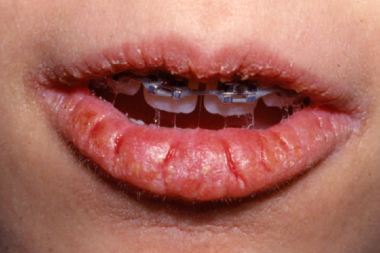Published on
Differential Diagnosis
- Contact dermatitis
- Cheilitis
- Acne vulgaris
- Urticaria

Diagnosis
The patient has cheilitis, which appears as dry, scaly patches on the lips. There may also be edema and erythema. Many cases represent a factitial disorder related to lip-licking habits, and it can be difficult to convince patients that the vermilion zone of the lip should be dry (the “wet line” is the demarcation between the labial mucosa and vermilion zone).
Learnings/What to Look for
- Cheilitis may be related to contact hypersensitivity reactions to compounds found in products that commonly come into contact with the vermilion zone of the lip, including cosmetics, lip balms, toothpastes, and sunscreens (oxybenzone [benzophenone-3]). Other causative factors include:
- Candidal infection related to chronic lip-licking or to the use of petrolatum-based materials that are applied to the lips. (The petrolatum seals in moisture, allowing the candidal organism to thrive in the moist keratin that results)
- Retinoids (isotretinoin and acitretin)
- High doses of vitamin A, lithium, chemotherapeutic agents (busulfan and actinomycin), d-penicillamine, isoniazid, and phenothiazine
Pearls for Urgent Care Management and Considerations for Transfer
- Treatment of infection with clotrimazole troches, miconazole mucoadhesive tablets, or nystatin swish and swallow
- Counsel the patient to resist licking their lips
- Consider use of lip moisturizers and emollients
Acknowledgment: Images and case presented by VisualDx (www.VisualDx.com/JUCM).
View Similar Clinical Challenges
A 13-Year-Old Girl with Scaling and Fissures on Her Lips
1 2
